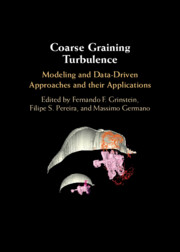Book contents
- Frontmatter
- Contents
- Contributors
- Prologue
- Part I Paradigms and Tools
- Part II Challenges
- 9 Transition to Turbulence
- 10 Wall-Bounded Turbulence
- 11 Scale-by-Scale Nonequilibrium in Turbulent Flows
- 12 Coarse-Graining in Multiphase Flows: From Micro to Meso to Macroscale for Euler–Lagrange and Euler–Euler Simulations
- 13 Coarse Graining for Thermal Flows
- 14 High-Order Simulations of Supersonic Combustion
- 15 Coarse-Graining Supersonic Combustion
- 16 Transition and Multiphysics in Inertial Confinement Fusion Capsules
- 17 Firestorms, Fallout, and Atmospheric Turbulence Induced by a Nuclear Detonation
- Epilogue
- Abbreviations
- Index
- References
13 - Coarse Graining for Thermal Flows
from Part II - Challenges
Published online by Cambridge University Press: 31 January 2025
- Frontmatter
- Contents
- Contributors
- Prologue
- Part I Paradigms and Tools
- Part II Challenges
- 9 Transition to Turbulence
- 10 Wall-Bounded Turbulence
- 11 Scale-by-Scale Nonequilibrium in Turbulent Flows
- 12 Coarse-Graining in Multiphase Flows: From Micro to Meso to Macroscale for Euler–Lagrange and Euler–Euler Simulations
- 13 Coarse Graining for Thermal Flows
- 14 High-Order Simulations of Supersonic Combustion
- 15 Coarse-Graining Supersonic Combustion
- 16 Transition and Multiphysics in Inertial Confinement Fusion Capsules
- 17 Firestorms, Fallout, and Atmospheric Turbulence Induced by a Nuclear Detonation
- Epilogue
- Abbreviations
- Index
- References
Summary
Numerical investigations of convective flow and heat transfer in two different engineering applications, namely cross-corrugated channels for heat exchangers and rib-roughened channels for gas turbine blade cooling, using wall-modeled large eddy simulations (LES), are presented in this chapter. Mesh resolution requirements for LES, subgrid model dependence, and heat transfer and friction factor characteristics are investigated and compared with previously published experimental data. The LES computations form a coherent suite of monotonically behaving predictions, with all aspects of the results converging toward the predictions obtained on the finest grids. Various subgrid and Reynolds-averaged Navier–Stokes equations (RANS) models are compared to account for their reliability and efficiency in the prediction of hydraulic and thermal performances in the presence of complicated flow physics. Results indicate that subgrid models such as wall-adapting local eddy viscosity model (WALE) and localized dynamic kinetic energy model (LDKM) provide the most accurate results, within 201b of Nusselt number and Darcy’s friction factor, compared to selected RANS models, which presents up to 3501b deviation from experimental data. The conclusion is that both LES and RANS have their strengths and weaknesses, and the choice between them depends on the specific application requirements and available computational resources.
- Type
- Chapter
- Information
- Coarse Graining TurbulenceModeling and Data-Driven Approaches and their Applications, pp. 381 - 418Publisher: Cambridge University PressPrint publication year: 2025

